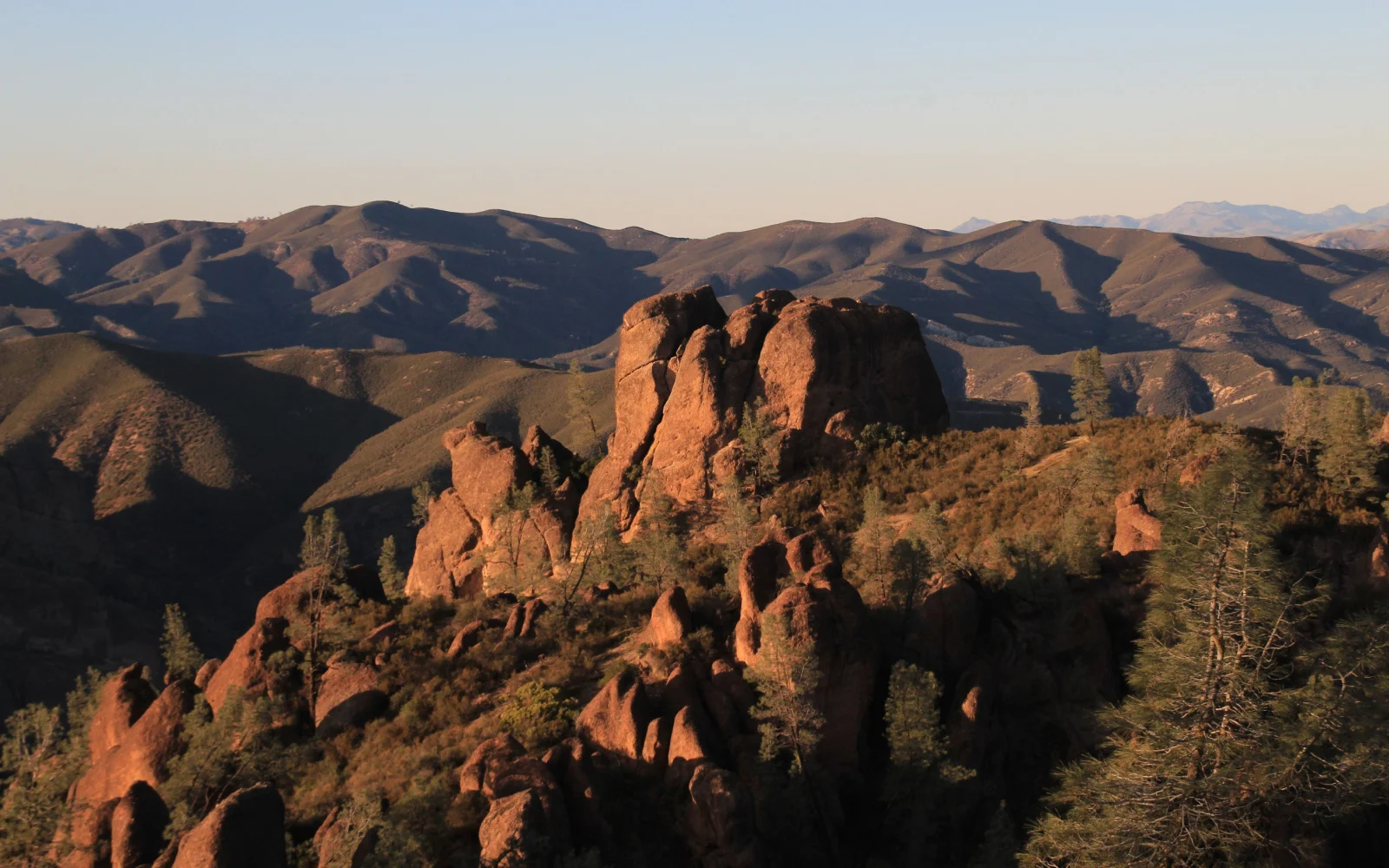What's the best time to visit Pinnacles National Park?
The best time to visit Pinnacles National Park is in spring (March–May), when mild weather supports hiking and the park’s wildflowers are in full bloom. Spring also offers excellent birdwatching opportunities and a variety of ranger-led programs. Despite its popularity during this season, the park rarely feels overcrowded, but parking spaces can fill up quickly, and we suggest booking your flight and hotel early.
Pinnacles National Park is one of California’s lesser-known parks, but it’s worth a visit for lovers of nature and otherworldly landscapes. Pinnacles National Park covers an alien-like volcanic landscape that includes monoliths, canyons, and rock formations that are spectacular to look at.
Besides hiking through the rocks, you can explore the chaparral landscape, a type of shrubland only found in California, try your hand at rock climbing, or keep an eye out for the rare California condor.
Pinnacles is one of the newest national parks in the United States and absolutely deserves a visit on your tour of California. Keep reading to learn more about the best time to visit.
Overall Best Time to Visit Pinnacles National Park
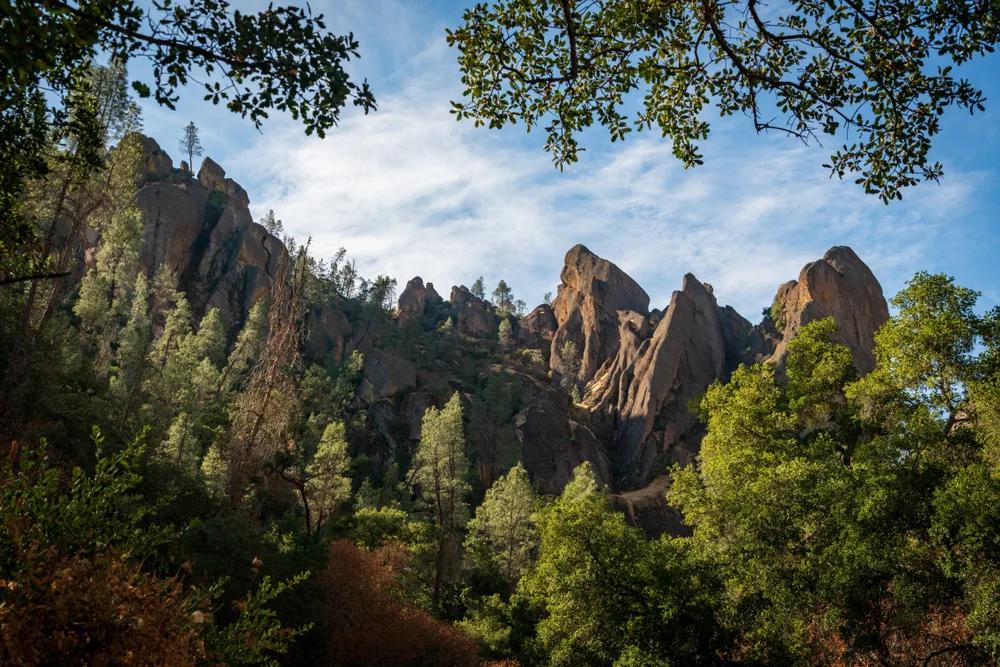
Zack Frank/Shutterstock
The best time to visit Pinnacles National Park is in the spring (March–May), which has the best weather and is when you’ll get to see the park’s famous wildflowers.
Pinnacles National Park, unlike many other national parks even in California, has a mild Mediterranean climate. That means that you can expect warm, sometimes hot, summers and mild weather throughout the rest of the year.
Spring weather is some of the most pleasant in the park. Average daily high temperatures are already 65 degrees by March (just expect the temperature to drop 20 or more degrees as soon as night falls).
By the end of March, the chance of cloud coverage and rain greatly decreases, so much so that you have a very high chance of only sunny days for exploring the park.
The mild temperatures make spring one of the better seasons for strenuous activities like hiking and rock climbing. The park also offers ranger programs like guided walks and educational talks throughout fall, winter, and spring, with many events peaking in the spring.
Spring also brings one of the signature symbols of Pinnacles National Park—its wildflowers. Besides its craggy rock formations, the park is most famous for its hundreds of species of wildflowers.
According to the official National Park Service website, the peak season for catching flowers like bush poppies, California poppies, bush lupine, and more is from mid-March to May. Spring is also the best time of year to visit if you want to go birdwatching.
While the park is home to over 100 bird species all year round, some migratory species are only around in the spring. It’s nesting season for birds like falcons (although this means some rocks are closed for climbing to avoid disturbing the birds). You can also catch mating songs and displays during this season.
While spring is one of the more popular times to visit Pinnacles National Park, the crowds rarely get overwhelming since this isn’t one of the well-known parks. However, keep in mind that facilities like parking lots may fill up quickly.
Cheapest Time to Visit Pinnacles National Park
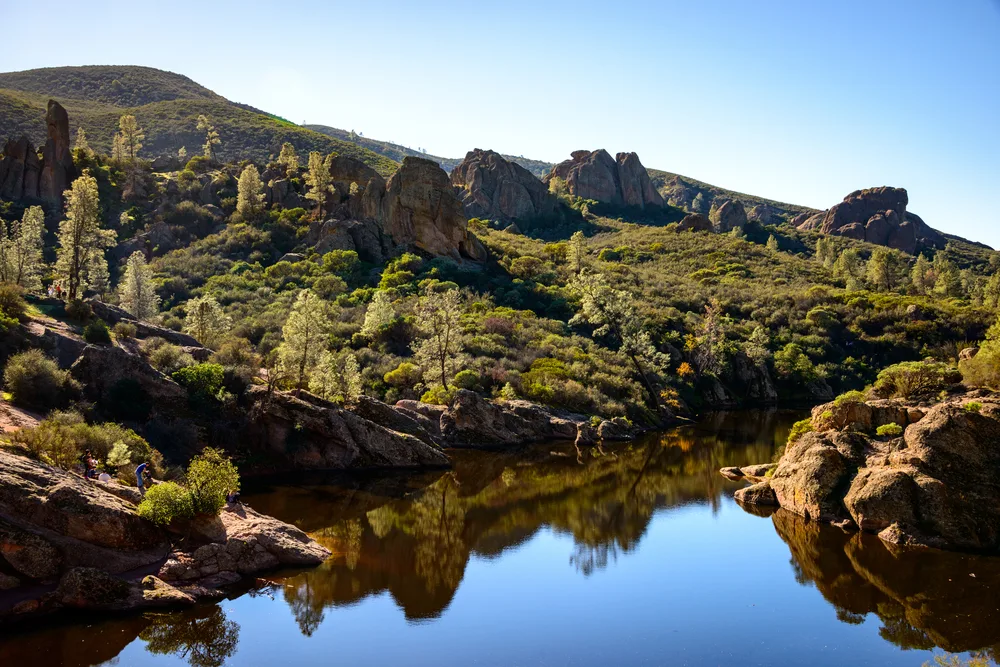
Zack Frank/Shutterstock
The cheapest time to visit Pinnacles National Park is in the late fall and winter (October–February). The cost of visiting the camp itself is the same all year round.
The park pass for a private vehicle is the same all year round, $30. The only accommodation option inside the park itself is Pinnacles Campground, which is open all year round and charges the same fee throughout the year.
If you don’t like to camp, you can stay in a hotel or lodge in one of the nearby towns in San Benito County. Hotel rates are much cheaper in the fall and winter than in the spring and summer, which are peak seasons for visitors.
Save $20–$30 on your accommodation per night by visiting between October and February. For out-of-state visitors, the cheapest time to visit is in the winter, when it’s cheapest to actually get to California.
The closest airport to Pinnacles National Park is Monterey Airport, but it may be cheaper to fly into San Francisco because it’s bigger and has more options. The cheapest months to fly into San Francisco and other northern Californian airports are November, February, and March.
Least Busy Time to Visit Pinnacles National Park
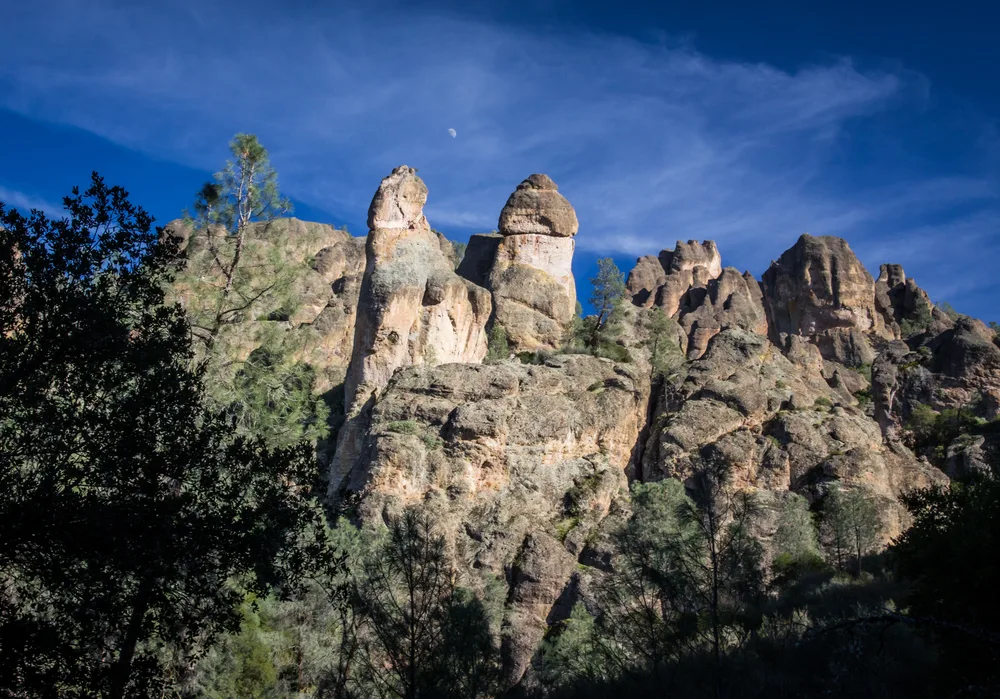
Ken Wolter/Shutterstock
The least busy time to visit Pinnacles National Park is in the winter, as there are fewer people around from November to February. It’s different from many other places in the national park system because it is very pleasant to visit in the winter.
Average daytime high temperatures are in the low 60s, even in December or January. Although the nights are much colder, this is great weather for a day hike if you go at a brisk pace and pack some layers.
By February, you can even see some early-blooming species of wildflowers. Milkmaids and shooting stars are just a few of the species that are early bloomers, some of them opening up as early as late January.
Thanks to the mild winter weather, you can do pretty much any activity that you would want to do during the spring or autumn, like hiking or rock climbing. Since it isn’t nesting season, you can actually climb more freely without having to worry about birds.
Winter also makes the parking situation a bit easier. Pinnacles National Park never reaches the crowds of Yosemite or Sequoia National Park, but during peak season, finding a place to park at popular trailheads after 8 A.M. is practically impossible.
Visit during the winter, and you should still come early in the morning (the parking lots aren’t that big) so that parking and getting around shouldn’t be as much of a hassle.
Worst Time to Visit Pinnacles National Park
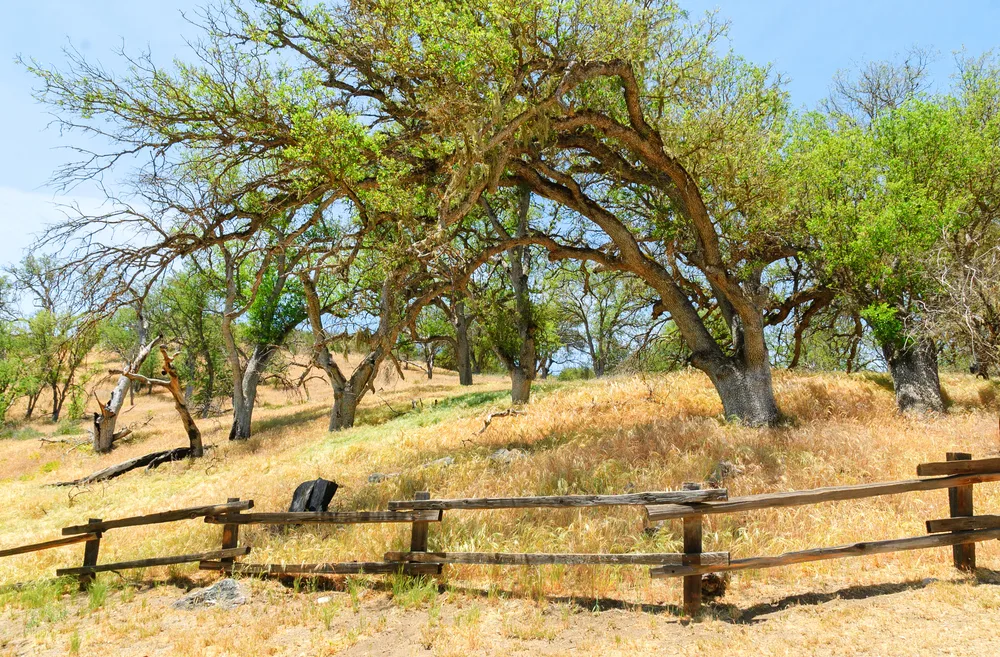
Zack Frank/Shutterstock
The worst time to visit Pinnacles National Park is during the summer, when temperatures are so high that it is downright unsafe to visit the park.
According to park authorities, summer temperatures in Pinnacles National Park regularly reach above 100 degrees Fahrenheit in July and August. There is no nearby body of water or ocean to provide a moderating influence on the climate.
Within the park, there is also very little shade since the landscape is made up of chaparral, or scrubland, not trees. All of these factors combined make for hiking conditions that are not just unpleasant but downright dangerous.
Unwitting visitors frequently suffer from dehydration or heatstroke inside the park, and rangers spend their summer conducting rescue operations. You don’t want your pleasant vacation to end in an emergency. There also isn’t much to do in the park during the summer.
The wildflower-strewn landscape becomes dry and dusty under the heat, and many animals stay out of the sun as well. There is little or no ranger programming in the summer as rangers are busy with necessary safety precautions.
Although there are fewer visitors, you won’t save much money because accommodations in nearby towns are at their priciest. If you decide to visit in the summer, just make sure to take the right safety precautions.
Try to visit early in the morning or late at night so you’re not outdoors during the worst of the day’s heat. Drink plenty of water and wear a cap and protective gear to protect yourself from the sun.
Things to Consider
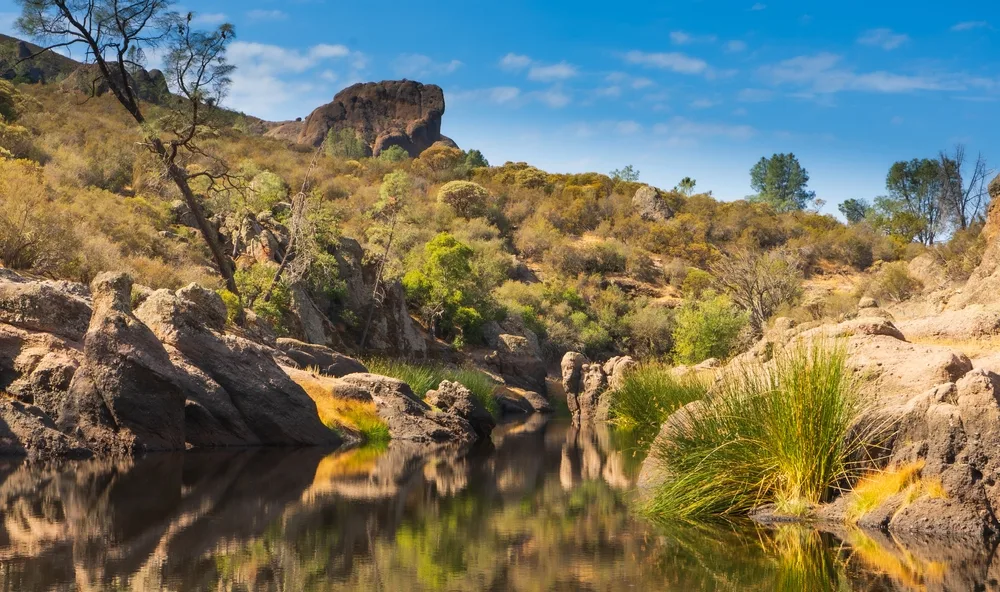
Ilya Khayn/Shutterstock
Still unsure about the best time to visit Pinnacles National Park? Take a look at our summary of the weather and climate by month below:
January
Winter temperatures at Pinnacles National Park range from 3 to 16°C (37-60°F). January is an excellent time for hiking the park’s trails, exploring the talus caves, and observing winter wildlife such as migratory birds.
February
Similar to January, February maintains cool temperatures between 4 to 17°C (39-63°F). Visitors can enjoy the quieter park, spot diverse bird species, and take advantage of the clear winter skies for stargazing.
March
As spring begins, temperatures range from 6 to 19°C (43-66°F). March is a great time for wildflower viewing, especially along the Condor Gulch and High Peaks trails. Spring also marks the nesting season for the California condors.
April
Spring temperatures in Pinnacles National Park range from 8 to 23°C (46-73°F). It’s an ideal time for hiking, rock climbing, and enjoying the vibrant wildflower displays. The Bear Gulch Reservoir is a picturesque spot for a picnic.
May
May sees temperatures ranging from 10 to 27°C (50-81°F). It’s a great month for exploring the park’s caves, birdwatching, and taking in the breathtaking views from the High Peaks. Longer daylight hours provide more time for outdoor activities.
June
Summer arrives with temperatures between 13 to 32°C (55-90°F). June offers opportunities for camping, rock climbing in the Bear Gulch area, and witnessing the park’s diverse plant life in full bloom.
July
July maintains warm temperatures from 15 to 35°C (59-95°F). It’s a popular month for stargazing events organized by the park, as well as exploring the diverse ecosystems along the Bench and Balconies trail.
August
Temperatures in August range from 15 to 35°C (59-95°F). It’s an excellent time for sunrise or sunset hikes to capture the beauty of the landscape. Visitors can also participate in ranger-led programs to learn more about the park’s geology and wildlife.
September
As fall begins, temperatures range from 13 to 32°C (55-90°F). September offers a pleasant transition, with opportunities for birdwatching, exploring the caves, and enjoying the changing colors of the landscape.
October
October sees temperatures ranging from 10 to 28°C (50-82°F). It’s a great month for hiking the Moses Spring to Rim Trail, rock climbing in the High Peaks, and attending ranger-led programs.
November
Fall temperatures range from 6 to 20°C (43-68°F). November is perfect for exploring the park’s quieter trails, observing wildlife preparing for winter, and taking in the scenery without the summer crowds.
December
Winter returns with temperatures ranging from 3 to 16°C (37-60°F). December brings opportunities for quiet contemplation, birdwatching, and enjoying the park’s serene winter atmosphere.
Frequently Asked Questions
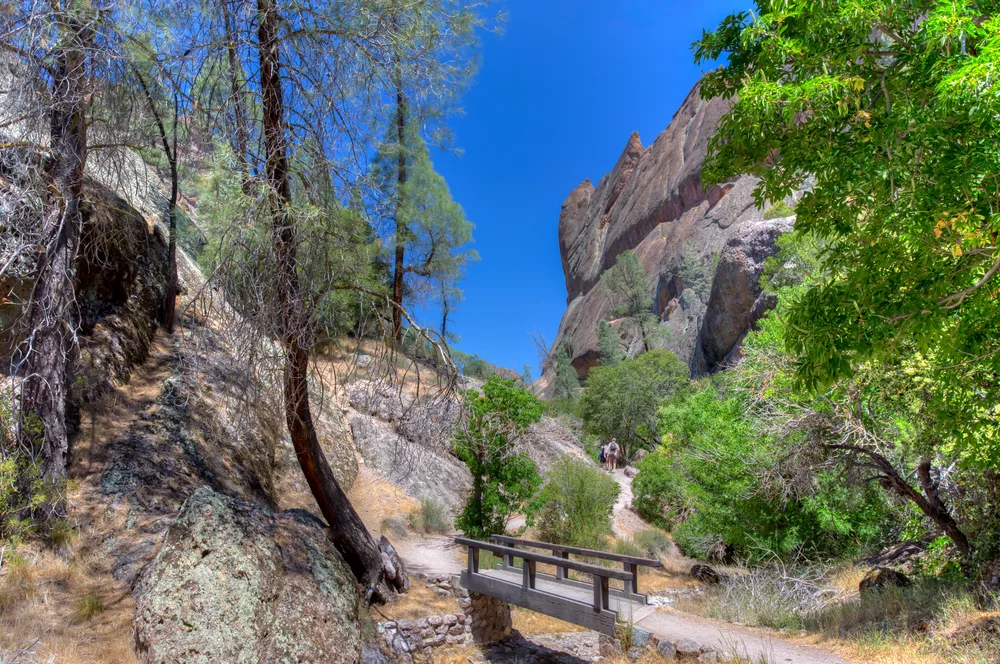
Ken Wolter/Shutterstock
Here are a few common questions people have asked about visiting Pinnacles National Park:
What is the best time to go to Pinnacles National Park?
The best time to go to Pinnacles National Park is in the spring or fall, which has mild weather and good hiking conditions.
Is Pinnacles National Park worth seeing?
Pinnacles National Park is worth seeing for its truly wild landscape but shouldn’t be your first choice if you have time for just one California national park.
How hot is Pinnacles National Park in July?
Pinnacles National Park is very hot in July, with average temperatures in the low 90s and days frequently hotter than 100 degrees.
What time does Pinnacles National Park open?
The West Side gate of Pinnacles National Park opens at 7:30 every morning, while the East Side is open 24 hours a day but doesn’t allow overnight parking.
How many days do you need in Pinnacles National Park?
You only need one or two days in Pinnacles National Park to explore because the park is fairly small. Even a few days are enough to explore the landscape.
So, What’s the Best Time to Visit Pinnacles National Park?
Pinnacles National Park is at its most beautiful during the spring wildflower season but is also great during the cooler winter or less crowded fall season. Avoid visiting in the summer due to dangerously high temperatures.
So, with so much to see and do and countless amazing times to visit, what are you waiting for — book your trip today and experience for yourself all that Pinnacles National Park has to offer. Happy travels!



